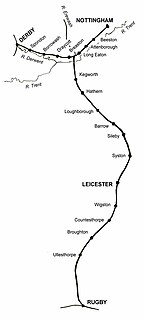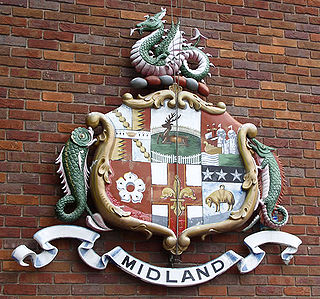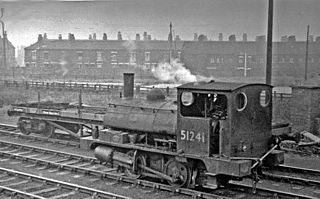Related Research Articles

The Midland Counties' Railway (MCR) was a railway company in the United Kingdom which existed between 1839 and 1844, connecting Nottingham, Leicester and Derby with Rugby and thence, via the London and Birmingham Railway, to London. The MCR system connected with the North Midland Railway and the Birmingham and Derby Junction Railway in Derby at what become known as the Tri Junct Station. The three later merged to become the Midland Railway.

The Locomotives of the Midland Railway, followed its small engine policy. The policy was later adopted by the London, Midland and Scottish Railway, and contrasted with the London and North Western Railway's policy. The small engine policy was partly the consequence of a difference in the background of senior managers. In most railway companies, the elite position was the design, construction and maintenance of locomotives. Bigger engines brought more prestige and allowed longer trains. In the Midland, the marketing department was paramount. They recognised that people wanted more frequent, shorter trains rather than an infrequent service. It concentrated on very light, very fast and frequent trains.

Under the Whyte notation for the classification of steam locomotives, 4-2-2 represents the wheel arrangement of four leading wheels on two axles, two powered driving wheels on one axle, and two trailing wheels on one axle.

Under the Whyte notation for the classification of steam locomotives, a 2-6-4 locomotive has two leading wheels, six coupled driving wheels and four trailing wheels. This arrangement is commonly called Adriatic.
The Highland Railway began as the Inverness and Nairn Railway, which operated the other lines which became part of the Highland Railway on its formation in 1865. For post-1870 locomotives, see Locomotives of the Highland Railway.
A number of different numbering and classification schemes were used for the locomotives owned by the London, Midland and Scottish Railway (LMS) and its constituent companies; this page explains the principal systems that were used.

The Birmingham and Derby Junction Railway was a British railway company. From Birmingham it connected at Derby with the North Midland Railway and the Midland Counties Railway at what became known as the Tri Junct Station. It now forms part of the main route between the West Country and the North East.

The L&YR Class 21 is a class of small 0-4-0ST steam locomotive built by the Lancashire and Yorkshire Railway for shunting duties. They were nicknamed Pugs.

The Midland Railway 115 Class is a class of 4-2-2 steam locomotive, nicknamed "Spinners". They were designed by Samuel Waite Johnson and a total of 15 of the class were built between 1896 and 1899. They were capable of reaching speeds of up to 90 miles per hour.
The Belfast and Northern Counties Railway (BNCR) Class A was a class of 13 two-cylinder compound steam locomotives built for service in north-east Ireland. The first two members of the class would be the last locomotives to be built for the independent BNCR, being completed before its purchase by the Midland Railway in 1903. The members of the class were rebuilt by the LMS (NCC) becoming either Class A1 or Class U2 depending on how they had been modified.
Little information remains about the North Midland Railway Locomotives. Unlike other railway companies, the North Midland Railway of England did not give names to its locomotives.
The first 19 locomotives ordered by Isambard Kingdom Brunel for the Great Western Railway included six 2-2-2 Mather, Dixon locomotives. They were built by Mather, Dixon and Company, but were unsuccessful, and were rapidly replaced by the Star Class locomotives ordered by Daniel Gooch, once he had been appointed as the Locomotive Engineer.
The Midland Railway Johnson 0-6-0 were a class of locomotives serving Britain's Midland Railway system in the late 19th and early 20th centuries. Between 1875 and 1908 the Midland Railway, under the control of locomotive superintendents Samuel Waite Johnson and Richard Deeley, ordered 935 goods tender engines of 0-6-0 type, both from the railway's own shops at Derby and various external suppliers. Although there were many variations between different batches both as delivered and as successively rebuilt, all 935 can be regarded as a single series, one of the largest classes of engine on Britain's railways. The locomotives served as late as 1964, but none of them now survive.
The Midland Railway (MR) 1322 Class was a class of small 0-4-0ST steam locomotives designed for shunting. The next class of shunting engines built by the Midland was the 1116A Class, which was nearly identical.

The Midland Railway 1252 class was a class of 30 0-4-4T locomotives built by Neilson and Company in 1875–1876 to the design of Samuel W. Johnson. They were a development of the 6 Class. Originally numbers 1262–1281 and 1252–1261. Under the Midland Railway's 1907 renumbering scheme they became 1236–1265.
The Midland Railway 2501 Class was a class of 2-6-0 steam locomotives built in the United States in 1899. The Midland's own Derby Works had reached their capacity, and were unable to produce additional engines at the time, and many British locomotive builders were recovering from a labor dispute over working hours, thus the railway placed an order with the Baldwin Locomotive Works for 30 engines. The engines were shipped disassembled as kits of parts, and re-assembled at Derby. Baldwin constructed similar 2-6-0's for the Great Central Railway and Great Northern Railway around the same time.
The NBR 141 Class consisted of two steam locomotives of the 2-4-0 wheel arrangement built by the North British Railway (NBR) in 1869. They were the direct antecedents of the NBR 224 Class 4-4-0.
The Midland Railway 1532 class was a class of 65 0-4-4T locomotives built by Derby Works between 1881 and 1886 to the design of Samuel W. Johnson. They were a development of the 1252 class. Originally numbered 1532–1551, 1632–1656, and 1718–1737; under the 1907 renumbering scheme they became 1266–1330, and were given the power classification 1P.

The LNWR 18-inch Tank class was a class of 80 0-6-2T locomotives built by the London and North Western Railway in their Crewe Works between 1898 and 1902.

The LNWR 5ft 6in Tank was a class of 160 passenger 2-4-2T locomotives manufactured by the London and North Western Railway in their Crewe Works between 1890 and 1897. The "5ft 6in" in the title referred to the diameter of the driving wheels – although the stated dimension was for the wheel centres – the nominal diameter including the tyres was 5 ft 8 1⁄2 in (1,740 mm).